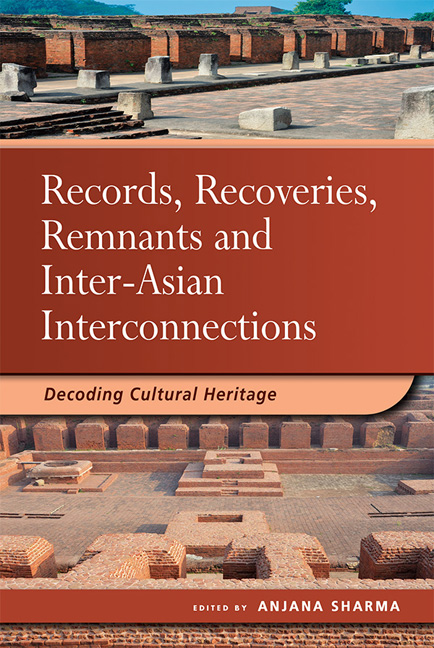Book contents
- Frontmatter
- Dedication
- Contents
- Contributors
- Acknowledgements
- 1 Introduction: Records, Recoveries, Remnants and Inter-Asian Interconnections — Decoding Cultural Heritage
- 2 Negotiating Place and Heritage: Creating Nalanda University
- 3 India, Magadha, Nalanda: Ecology and a Premodern World System
- 4 Collecting the Region: Configuring Bihar in the Space of Museums
- 5 Heritage Preservation in the Gaya Region
- 6 Setting the “Records” Straight: Textual Sources on Nālandā and Their Historical Value
- 7 “Central India Is What Is Called the Middle Kingdom”
- 8 The Object | The Tree: Emissaries of Buddhist Ground
- 9 Tracing Transregional Networks and Connections Across the Indic Manuscript Cultures of Nusantara (AD 1400–1600)
- 10 Seeking a Sufi Heritage in the Deccan
- 11 Archaeological Remains at Nalanda: A Spatial Comparison of Nineteenth Century Observations and the Protected World Heritage Site
- 12 A Heritage Gem Sits in the Heart of a City, Unacknowledged, Incognito: The Case for Recognizing Kolkata Chinatown as a Historic Urban Landscape
- Index
- Miscellaneous Endmatter
11 - Archaeological Remains at Nalanda: A Spatial Comparison of Nineteenth Century Observations and the Protected World Heritage Site
Published online by Cambridge University Press: 04 July 2018
- Frontmatter
- Dedication
- Contents
- Contributors
- Acknowledgements
- 1 Introduction: Records, Recoveries, Remnants and Inter-Asian Interconnections — Decoding Cultural Heritage
- 2 Negotiating Place and Heritage: Creating Nalanda University
- 3 India, Magadha, Nalanda: Ecology and a Premodern World System
- 4 Collecting the Region: Configuring Bihar in the Space of Museums
- 5 Heritage Preservation in the Gaya Region
- 6 Setting the “Records” Straight: Textual Sources on Nālandā and Their Historical Value
- 7 “Central India Is What Is Called the Middle Kingdom”
- 8 The Object | The Tree: Emissaries of Buddhist Ground
- 9 Tracing Transregional Networks and Connections Across the Indic Manuscript Cultures of Nusantara (AD 1400–1600)
- 10 Seeking a Sufi Heritage in the Deccan
- 11 Archaeological Remains at Nalanda: A Spatial Comparison of Nineteenth Century Observations and the Protected World Heritage Site
- 12 A Heritage Gem Sits in the Heart of a City, Unacknowledged, Incognito: The Case for Recognizing Kolkata Chinatown as a Historic Urban Landscape
- Index
- Miscellaneous Endmatter
Summary
The archaeological site of Nalanda has been inscribed in the UNESCO World Heritage List of 2016. One of the key requirements put forth by the World Heritage Convention (WHC) for such recognition is to geospatially identify core and buffer zones of the inscribed property. This essay analyses these inscribed zones in the spatial context of records and maps of archaeological remains at Nalanda created by Francis Buchanan- Hamilton, Alexander Cunningham and Alexander M. Broadley in the nineteenth century. Using recent satellite imagery and associated geospatial techniques together with ground observations, this essay firstly, identifies the geographical location of all features mapped and recorded by the three British explorers in and around Nalanda, secondly presents a visual comparison of the property inscribed as a World Heritage site and the expanse of archaeological features noticed in nineteenth century (some of which still exist, yet lie outside the core and buffer zones), and finally records the present land-use along those features (via visual interpretation of the latest satellite imagery and field visit) in order to identify locations where there is high potential for heritage conservation.
INTRODUCTION
Nalanda was a Buddhist monastery of considerable repute which attracted scholars from great distances. Accounts of visitors from China (dating from the seventh century AD) suggest that Nalanda was a large, thriving establishment whose physical dimensions were immense. This institution seems to have remained in existence from the fourth/fifth century to at least until the end of the twelfth century. It is unknown exactly when this centre came into existence, and we do not have a continuous record for its activities. It must have gained a reputation for importance by the seventh century AD, attracting scholarly monks such as Xuanzang and Yijing from China. Tibetan monk Dharmasvamin records some lingering activity in the monastery with a handful of monks during his visit in 1234–36 AD. There is sparse historical documentation about Nalanda in the subsequent centuries, and the very existence of this mega monastery was forgotten in that region.
The site was visited by Francis Buchanan in 1812, a Scottish physician, who surveyed the region that would later be known as Nalanda as part of a survey of the territories forming the Presidency of Fort William.
- Type
- Chapter
- Information
- Records, Recoveries, Remnants and Inter-Asian InterconnectionsDecoding Cultural Heritage, pp. 239 - 256Publisher: ISEAS–Yusof Ishak InstitutePrint publication year: 2018



